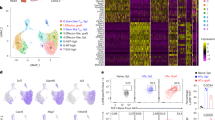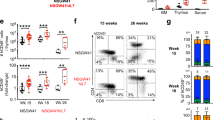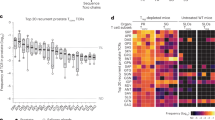Abstract
T CELLS express T-cell antigen receptors (TCR) for the recognition of antigen in conjunction with the products of the major histocompatibility complex1,2. They also express two key surface coreceptors, CD4 and CDS, which are involved in the interaction with their ligands3,4. As CD4 is expressed on the early haemopoietic progenitor5 as well as the early thymic precursor cells6, a role for CD4 in haemopoiesis and T-cell development is implicated. Thymocytes undergo a series of differentiation7 and selection steps8,9 to become mature CD4+8− or CD4−8+ (single positive) T cells10,11. Studies of the role of CD4+ T cells in vivo have been based on adoptive transfer of selected or depleted lymphocytes, or in vivo treatment of thymectomized mice with monoclonal antibodies causing depletion of CD4+ T cells12–14. In order to study the role of the CD4 molecule in the development and function of lymphocytes, we have disrupted the CD4 gene in embryonic stem cells15–16 by homologous recombination17–18. Germ-line transmission19–20 of the mutation produces mutant mouse strains that do not express CD4 on the cell surface. In these mice, the development of CD8+ T cells and myeloid components is unaltered, indicating that expression of CD4 on progenitor cells and CD4+ CD8+ (double positive) thymocytes is not obligatory. Here we report that these mice have markedly decreased helper cell activity for antibody responses, although cytotoxic T-cell activity against viruses is in the normal range. This differential requirement for CD4+ helper T cells is important to our understanding of immune disorders, including AIDS, in which CD4+ cells are reduced or absent.
This is a preview of subscription content, access via your institution
Access options
Subscribe to this journal
Receive 51 print issues and online access
$199.00 per year
only $3.90 per issue
Buy this article
- Purchase on SpringerLink
- Instant access to full article PDF
Prices may be subject to local taxes which are calculated during checkout
Similar content being viewed by others
References
Yanagi, Y. et al. Nature 308, 145–149 (1984).
Hedrick, S. M., Cohen, D. I., Nielsen, E. A. & Davis, M. M. Nature 308, 149–153 (1984).
Parnes, J. R. Adv. Immun. 44, 265–311 (1989).
Schwartz, R. H. A. Rev. Immun. 3, 237–261 (1985).
Fredrickson, G. G. & Basch, R. S. J. exp. Med. 169, 1473–1478 (1989).
Wu, L. et al. Nature 349, 71–74 (1991).
Scollay, R. et al. Immunol. Rev. 104, 81–120 (1988).
Kappler, J. W., Roehm, N. & Marrack, P. Cell 49, 273–280 (1987).
Kisielow, P., Bluthmann, H., Staerz, U. D., Steinmetz, M. & Von Boehmer, H. Nature 333, 742–746 (1988).
Mathieson, B. J. & Fowlkes, B. J. Immunol. Rev. 82, 141–173 (1984).
Scollay, R., Bartlett, P. & Shortman, K. Immunol. Rev. 82, 79–103 (1984).
Cobbold, S. P., Jayasuriya, A., Nash, A., Prospero, T. D. & Waldmann, H. Nature 312, 548–551 (1984).
Cobbold, S. P. & Waldmann, H. Transplantation 41, 634–639 (1986).
Leist, T. P., Cobbold, S. P., Waldmann, H., Aguet, M. & Zinkernagel, R. M. J. Immun. 138, 2278–2281 (1987).
Evans, M. J. & Kaufman, M. H. Nature 22, 154–156 (1981).
Martin, G. R. Proc. natn. Acad. Sci. U.S.A. 78, 7634–7638 (1981).
Smithies, O., Gregg, R. G., Boggs, S. S., Koralewski, M. A. & Kucherlapati, R. S. Nature 317, 230–234 (1985).
Thomas, K. R. & Capecchi, M. R. Cell 51, 503–512 (1987).
Gossler, A., Doetschman, T., Korn, R., Serfling, E. & Kemler, R. Proc. natn. Acad. Sci. U.S.A. 83, 9065–9069 (1986).
Robertson, E., Bradley, A., Kuehn, M. & Evans, M. Nature 323, 445–447 (1986).
Fung-Leung, W. P. et al. Cell, 65, 443–449 (1991).
Cantor, H. & Boyse, E. A. J. exp. Med. 141, 1376–1399 (1975).
Bennink, J. R. & Doherty, P. C. Nature 276, 829–831 (1978).
Ashman, R. B. & Mullbacher, A. J. exp. Med. 150, 1277–1282 (1979).
Kast, W. M., Bronkhorst, A. M., de Waal, L. P. & Melief, C. J. J. exp. Med. 164, 723–738 (1986).
Zinkernagel, R. M. et al. J. exp. Med. 147, 897–911 (1978).
Leist, T. P., Kohler, M. & Zinkernagel, R. M. Scand. J. Immun. 30, 679–686 (1989).
Ahmed, R., Butler, L. D. & Bhatti, L. J. Virol. 62, 2102–2106 (1988).
Buller, R. M. L., Holmes, K. L., Hugin, A., Fredrickson, T. N. & Morse, H. C. Nature 328, 77–79 (1987).
Nash, A. A. et al. J. gen. Virol. 68, 825–833 (1987).
Pfizenmaier, K. et al. Eur. J. Immun. 14, 33–39 (1984).
Williams, L. R. et al. Nature 336, 684–687 (1988).
Joyner, A. L., Skarnes, W. C. & Rossant, J. Nature 338, 153–156 (1989).
Gillis, S., Ferm, M. M., Ou, W. & Smith, K. A. J. Immun. 120, 2027–2032 (1978).
Hudson, L. & Hay, F. C. in Practical Immunology (Blackwell, Oxford, 1989).
Author information
Authors and Affiliations
Rights and permissions
About this article
Cite this article
Rahemtulla, A., Fung-Leung, W., Schilham, M. et al. Normal development and function of CD8+ cells but markedly decreased helper cell activity in mice lacking CD4. Nature 353, 180–184 (1991). https://doi.org/10.1038/353180a0
Received:
Accepted:
Issue Date:
DOI: https://doi.org/10.1038/353180a0



